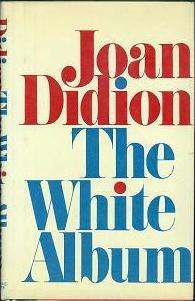The White Album (book)
 First edition | |
| Author | Joan Didion |
|---|---|
| Country | United States |
| Language | English |
| Genre | Essays |
| Publisher | Simon & Schuster |
Publication date | 1979 |
| Media type | Print (Hardback & Paperback) |
| Pages | 222 |
| ISBN | 0-671-22685-1 |
| OCLC | 23163086 |
The White Album is a 1979 book of essays by Joan Didion. Like her previous book Slouching Towards Bethlehem, The White Album is a collection of works previously published in magazines such as Life and Esquire. The subjects of the essays range widely and represent a mixture of memoir, criticism, and journalism, focusing on the history and politics of California in the late 1960s and early 70s. With the publication of The White Album, Didion had established herself as a prominent writer on Californian culture. As one contemporary reviewer stated, "California belongs to Joan Didion."[1]
The title of the book comes from its first essay, "The White Album," which was chosen as one of the 10 most important essays since 1950 by Publishers Weekly.[2] The opening sentence of this essay—"We tell ourselves stories in order to live"—would become one of Didion's best-known[3] sayings, and was used as the title of a 2006 collection of Didion's nonfiction.
Contents
The White Album is organized into five sections. The first section contains only the title essay, while the other four sections are identified by a major topic or theme, such as "California Republic" or "Women."
I. The White Album
- "The White Album" (1968–78)
"The White Album" is an autobiographical literary essay detailing loosely related events in the author's life in the 1960s, primarily in Los Angeles, California. In the course of describing her ongoing psychological difficulties, Didion discusses Black Panther Party meetings, drug-related experiences, a Doors recording session, various other interactions with LA musicians and cultural figures and several prison meetings with Linda Kasabian, a former follower of Charles Manson who was testifying against the group for the grisly Sharon Tate murders. Tate had been an acquaintance of Didion's. The murder trial cast a cloud of fear over Hollywood that seemed to propel many of Didion's insights. The impression conveyed is one of a city and nation pervaded by paranoia and detachment.
However, the ending, in which the author moves away from what she feels to be the unstable world of Hollywood and renovates an old house that possesses a few lingering associations with the 1960s, indicates that for her there is still the possibility of escaping the paranoia and unrest of that decade.
Martin Amis wrote critically of the book:
[Didion] stands revealed, in The White Album, as a human being who has managed to gouge another book out of herself, rather than as a writer who gets her living done on the side, or between the lines. The result is a volatile, occasionally brilliant, distinctly female contribution to the new New Journalism, diffident and imperious by turns, intimate yet categorical, self-effacingly listless and at the same time often subtly self-serving. She can still find her own perfect pitch for long stretches, and she has an almost embarrassingly sharp ear and unblinking eye for the Californian inanity. Seemingly obedient, though, to the verdicts of her psychiatric report, Miss Didion writes about everything with the same doom-conscious yet faintly abstract intensity of interest, whether remarking on the dress sense of one of Manson’s henchwomen, or indulging her curious obsession with Californian waterworks in these pieces, Miss Didion’s writing does not "reflect" her moods so much as dramatise them. "How she feels" has become, for the time being, how it is.[4]
II. California Republic
|
III. Women
|
IV. Sojourns
|
V. On the Morning After the Sixties
|
External links
References
- ↑ Kakutani, Michik. "Joan Didion: Staking Out California." The New York Times. Accessed November 7, 2014.
- ↑ "The Top 10 Essays Since 1950". Publishers Weekly. Retrieved April 22, 2013.
- ↑ "'We tell ourselves stories in order to live,' Didion famously wrote in The White Album." Schine, Cathleen. "Elegy to the Void." The New York Review of Books. Accessed November 7, 2014.
- ↑ Amis, Martin (February 1980) "Joan Didion's Style." London Review of Books, Vol II No 2. Page 3-4. (Retrieved 10-16-2014.)